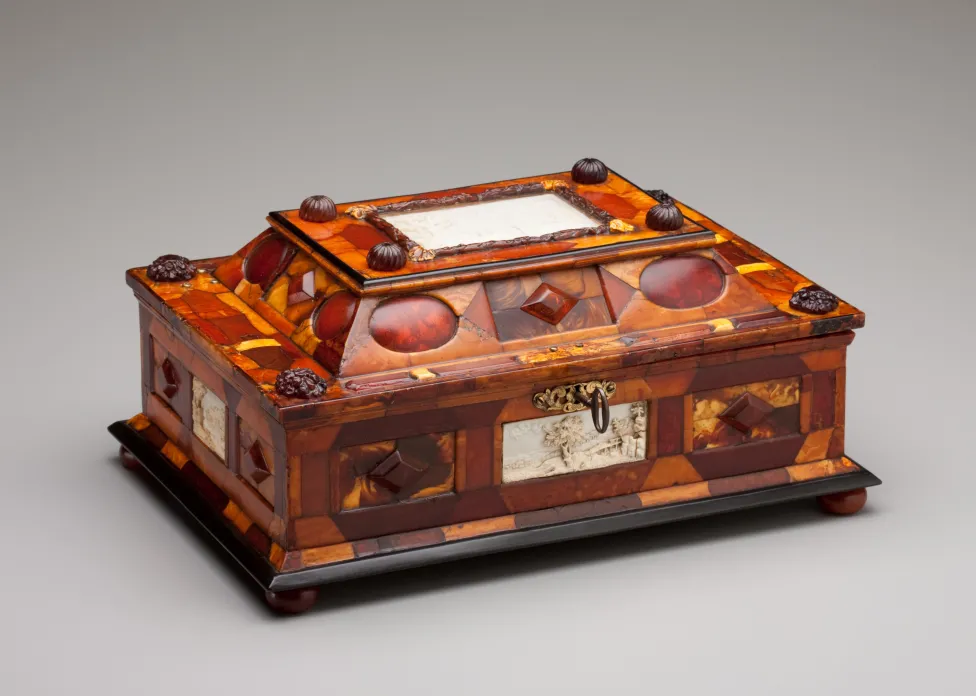Material Literacy in Early Modern Europe: The DIA Amber Casket and the Natural World, ca. 1695
Register:
Tuesday, May 14, 2024
6
– 7 p.m.
| Free with general admission |
*General museum admission is FREE for residents of Macomb, Oakland and Wayne counties.
Location:
Lecture Hall
5200 Woodward Ave
Detroit, MI 48202
United States
Fashioned around 1695 and attributed to Gottfried Wolffram, the DIA’s amber casket exemplifies the early modern practice of using materials from formerly living organisms and the inorganic materials whose extraction adversely affected the environment. Comprising amber, ivory, wood, velvet, paper, gold, and brass, the casket's diverse materials not only showcase artistic versatility but also hint at environmental impacts in regions like Prussia, Lithuania, Sweden, East Africa, and the Americas.
Contrasting sharply with our contemporary, often limited grasp of the origins, processing, and assembly of materials, early modern craftspeople and the European elites had a far deeper understanding of artifacts’ structural logic and their constituent materials. This tacit knowledge, increasingly recognized as “material literacy,” profoundly shaped the interpretation and appreciation of art. With this backdrop, Dr. Tomasz Grusiecki will investigate how early modern Europeans understood the materials that make up the DIA’s casket. He will examine the range of responses elicited by the scarcity, abundance, and ecological implications of various artistic media. Investigating the materials’ relationship to the natural world, as well as their extraction, refinement, and recycling, this lecture will provide insights into how environmental concerns of the period endowed art with added meaning and value.
About the lecturer: Dr. Tomasz Grusiecki is Associate Professor of Early Modern European Art and Material Cultures at Boise State University. His research encompasses early modern cultural entanglements, European perceptions of the wider world, eco-critical examinations of artistic materials, and zoopolitics of art-making, particularly in Central and Eastern Europe from 1500 to 1700. He is the author of Transcultural Things and the Spectre of Orientalism in Early Modern Poland-Lithuania (Manchester University Press, 2023).
Photo: Courtly amber casket, ca. 1695, attributed to Gottfried Wolffram. Collection: Detroit Institute of Arts, Museum Purchase, Robert H. Tannahill Foundation Fund.

Fashioned around 1695 and attributed to Gottfried Wolffram, the DIA’s amber casket exemplifies the early modern practice of using materials from formerly living organisms and the inorganic materials whose extraction adversely affected the environment. Comprising amber, ivory, wood, velvet, paper, gold, and brass, the casket's diverse materials not only showcase artistic versatility but also hint at environmental impacts in regions like Prussia, Lithuania, Sweden, East Africa, and the Americas.
Contrasting sharply with our contemporary, often limited grasp of the origins, processing, and assembly of materials, early modern craftspeople and the European elites had a far deeper understanding of artifacts’ structural logic and their constituent materials. This tacit knowledge, increasingly recognized as “material literacy,” profoundly shaped the interpretation and appreciation of art. With this backdrop, Dr. Tomasz Grusiecki will investigate how early modern Europeans understood the materials that make up the DIA’s casket. He will examine the range of responses elicited by the scarcity, abundance, and ecological implications of various artistic media. Investigating the materials’ relationship to the natural world, as well as their extraction, refinement, and recycling, this lecture will provide insights into how environmental concerns of the period endowed art with added meaning and value.
About the lecturer: Dr. Tomasz Grusiecki is Associate Professor of Early Modern European Art and Material Cultures at Boise State University. His research encompasses early modern cultural entanglements, European perceptions of the wider world, eco-critical examinations of artistic materials, and zoopolitics of art-making, particularly in Central and Eastern Europe from 1500 to 1700. He is the author of Transcultural Things and the Spectre of Orientalism in Early Modern Poland-Lithuania (Manchester University Press, 2023).
Photo: Courtly amber casket, ca. 1695, attributed to Gottfried Wolffram. Collection: Detroit Institute of Arts, Museum Purchase, Robert H. Tannahill Foundation Fund.